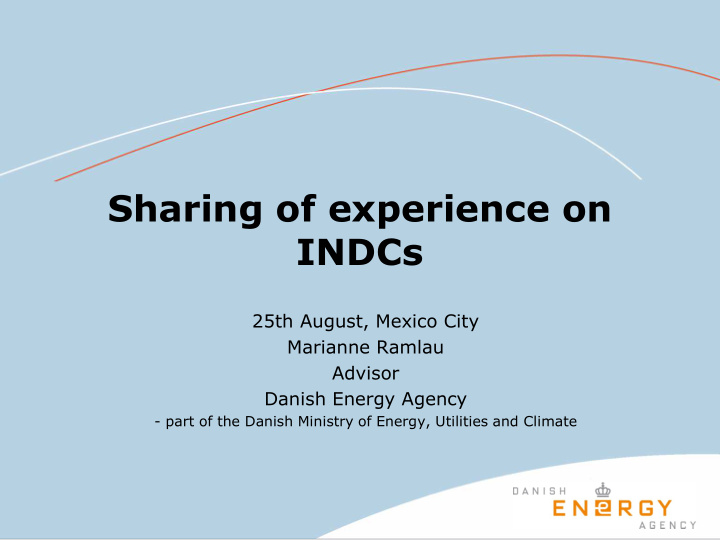



Sharing of experience on INDCs 25th August, Mexico City Marianne Ramlau Advisor Danish Energy Agency - part of the Danish Ministry of Energy, Utilities and Climate
Agenda • Overview of submitted INDCs Which countries and share of global emissions Analysis of emissions gap in 2030 Potential and measures to reduce emissions gap in 2030 • EU’s INDC target for 2030 T argets as per EU’s ‘Climate and Energy Package’ EU’s INDC target for 2030 Implementing the common target from the INDC Denmark’s commitments to the EU and national targets • Final remarks and conclusions
Overview of submitted INDCs • 28 countries and the European Union have submitted an INDC • These accounted for more than half of global GHG-emissions in 2010 Europe Middel East and Africa Asia Switzerland Gabon China EU Morocco Republic of Korea Norway Ethiopia Singapore Russia Kenya Japan Liecthenstein Benin Andorra Djibouti Serbia Democratic Republic of Iceland Congo Monaco Republic of Macedonia Latin America and the North America Oceania Caribbean Mexico United States of America New Zealand Trinidad and Tobago Canada Marshall Islands Dominican Republic Australia
Overview of submitted INDCs Prognosis on upcoming submissions • August: 18 • September: 33 • October: 17 • November: 6 • December: 1 (source: New Climate Institute – Progress of INDC preparation) • Call for the remaining countries to submit in due time to have the most comprehensive picture of global commitments ready for the COP in Paris
Analysis of emissions gap in 2030 Model used: COMPARE . • A global carbon market model to analyze international climate change agreements. • Based on the principle of cost-effectiveness. • Input data: • Marginal abatement cost curves (MACCs). Include emissions from CO2, non-CO2 and LULUCF sources (models: POLES, TIMER & IMAGE, G4M & GLOBIOM). • GDP historical values: World Bank. GDP growth rates (current: IMF (April 2013) and long-term: Centre for Prospective Studies and International Information (June 2013)). • Population growth rates ( UNDP’s medium fertility scenario, 2012 revision). • Baseline emissions from MACCs are calibrated to IEA’s Current Policy Scenario (IEA World Energy Outlook 2013).
Analysis of emissions gap in 2030 The INDCs close 19-41 pct. of the emissions gap in 2030. Around 55 per cent of global emissions in 2010 are covered by the INDCs so far.
Analysis of emissions gap in 2030 Comparing emissions per capita before and with INDC target (2010 vs. 2030): GHG per capita GHG per capita Country in 2010 in 2030 (tCOe2/cap) (tCO2e/cap) China 7.0 11-12.3 United States 19.1 10.4-11.1 EU28 8.8 6.2 Canada 22.7 13.6 Mexico 6.2 4.7-5.8
Potential to reduce emissions gap Hypothetical analysis: emissions gap is closed in 2030. Which sectors contain the cost-efficient reduction potentials? Most important sectors (pct. of gap closed): • Power (37 pct.) • Industry (30 pct.) • LULUCF (15 pct.) Deforestation very important!
EU’s INDC target for 2030
EU targets ”Climate and Energy Package” (2008) • Binding target of 20% GHG emissions reductions in 2020 compared to 1990 • Binding target of 20% of total gross final energy consumption in the EU from renewables in 2020 (national targets for individual member states), and at least 10% renewables in land transport • Non-binding target of 20% energy savings in 2020 through energy efficiency improvements
Targets as per EU’s ‘Climate and Energy Package’ (2008) Binding target of 20% GHG emissions reductions in 2020 compared to 1990: • EU ETS (emissions trading scheme) puts an EU-wide cap on 2020-emissions at 21% below 2005-emissions • Individual Member States 2020 targets for non-ETS sectors, set relative to 2005- emissions. Aggregate target for the EU(28): 10%
EU’s INDC target for 2030 • Binding target of at least 40 pct. domestic reduction in GHG emissions by 2030 compared to 1990.
Implementing the common target of the INDC • The European Commission has the initiative for implementing the INDC. • The Commission puts forward legislative proposals. • Proposals are negotiated with member states and the European Parliament until an agreement is reached. • Outstanding issues on the INDC: • Agreement on ETS (proposal is presented by now) • Agreement on burden sharing for non-ETS (proposal expected to be presented in 2016)
Commitments and national targets by Denmark DK’s EU commitment for National energy policy Projected compliance 2020 agreement (2012) Non-ETS sectors, 20% reduction Target for non-ETS sectors of 2005-level expected to be met (domestic GHG emissions projected to be reduced by 37% relative to 1990/95 incl. LULUCF) 30% RE share of final energy 35% 38% demand 10% RE share in transport 10.7% 50% of electricity demand from 51% wind power Targets for the long term European Union Danish government Danish Climate Law EU non-binding target of 85-90% Denmark should become Development towards low carbon reduction in 2050 compared independent from fossil fuel in economy with 1990 2050
Final remarks and conclusions INDC process: • It is very important to elaborate up front information in INDC submissions! • Great uncertainty in aggregate INDC gap assessment. • More action and ambition is needed – but it is possible to achieve the 2 degree pathway. Large potentials in power, industry and LULUCF sectors. • Delayed action increases mitigation costs. • INDCs are not the last step
Thank you for your attention! You are very welcome to contact sdo@ens.dk or swa@ens.dk.
Recommend
More recommend